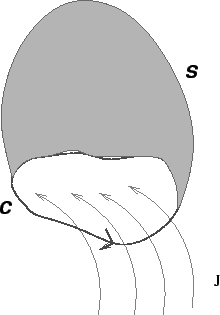Amperes Law
Amperes Law: Biot-Savart's law for magnetic field due to a current element is difficult to visualize physically as such elements cannot be isolated from the circuit which they are part of. Andre Ampere formulated a law based on Oersted's as well as his own experimental studies. Ampere's law states that `` the line integral of magnetic field around any closed path equals ![]() times the current which threads the surface bounded by such closed path. . Mathematically,
times the current which threads the surface bounded by such closed path. . Mathematically,
![]()
In spite of its apparent simplicity, Ampere's law can be used to calculate magnetic field of a current distribution in cases where a lot of information exists on the behaviour of ![]() . The field must have enough symmetry in space so as to enable us to express the left hand side of (1) in a functional form. The simplest application of Ampere' s law consists of applying the law to the case of an infinitely long straight and thin wire.
. The field must have enough symmetry in space so as to enable us to express the left hand side of (1) in a functional form. The simplest application of Ampere' s law consists of applying the law to the case of an infinitely long straight and thin wire.
Ampere's Law in Differential Form: We may express Ampere's law in a differential form by use of Stoke's theorem, according to which the line integral of a vector field is equal to the surface integral of the curl of the field,
![]()
The surface ![]() is any surface whose boundary is the closed path of integration of the line integral.
is any surface whose boundary is the closed path of integration of the line integral.

n terms of the current density ![]() , we have,
, we have, ![]()
where ![]() is the total current through the surface
is the total current through the surface ![]() . Thus, Ampere's law
. Thus, Ampere's law ![]() is equivalent to
is equivalent to
![]()
which gives ![]()
You may recall that in the case of electric field, we had shown that the divergence of the field to be given by ![]() . In the case of magnetic field there are no free sources (monopoles). As a result the divergence of the magnetic field is zero
. In the case of magnetic field there are no free sources (monopoles). As a result the divergence of the magnetic field is zero ![]()
The integral form of above is obtained by application of the divergence theorem
![]()
Thus the flux of the magnetic field through a closed surface is zero.